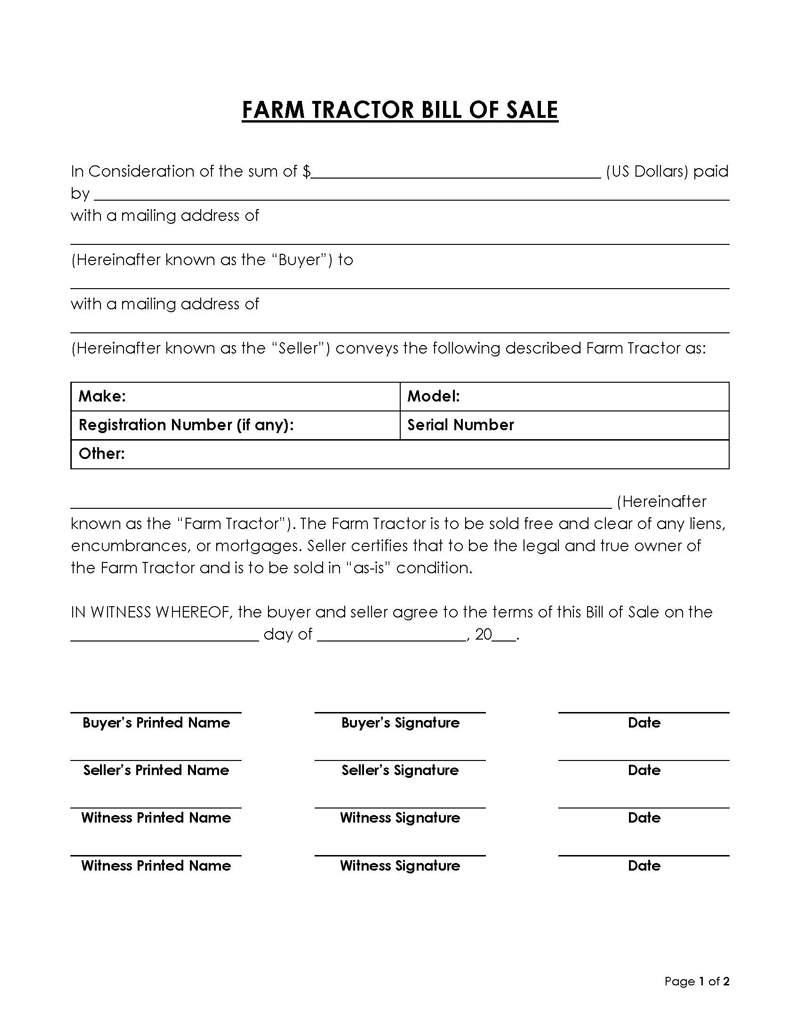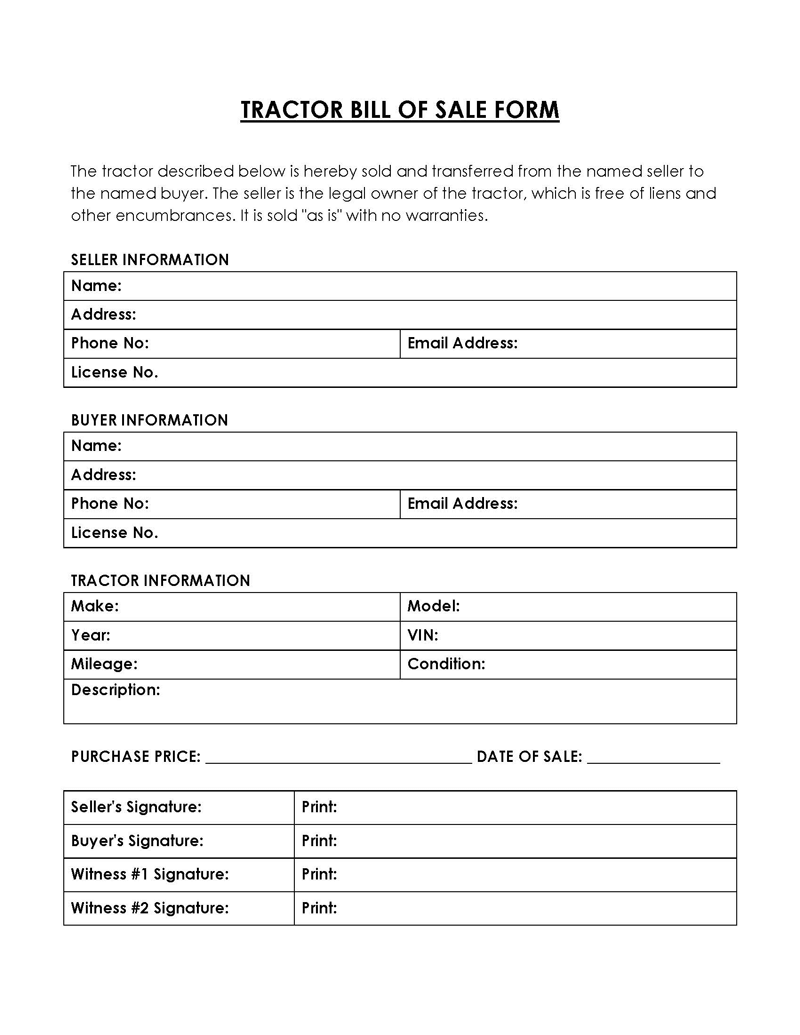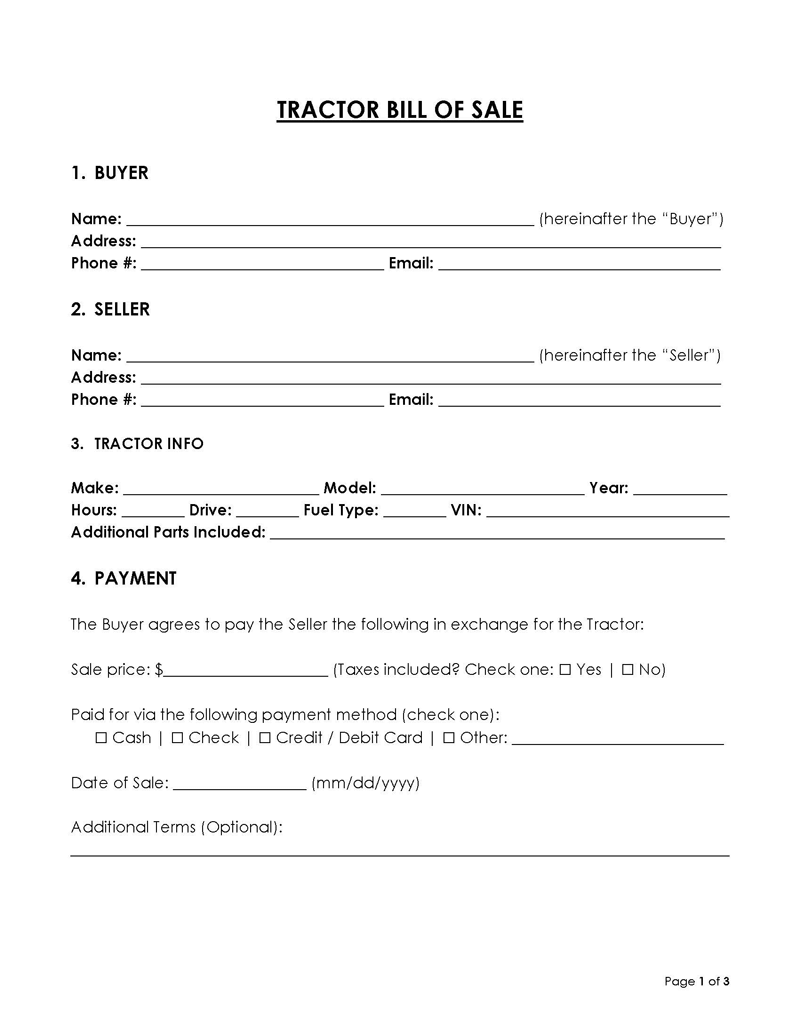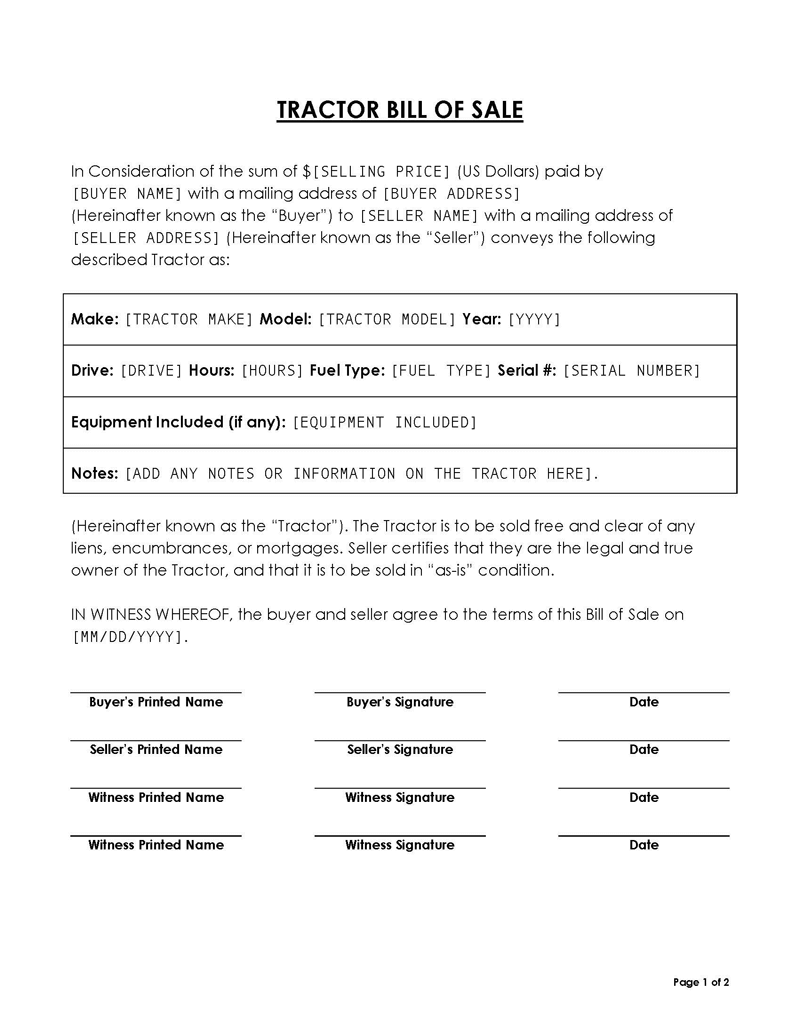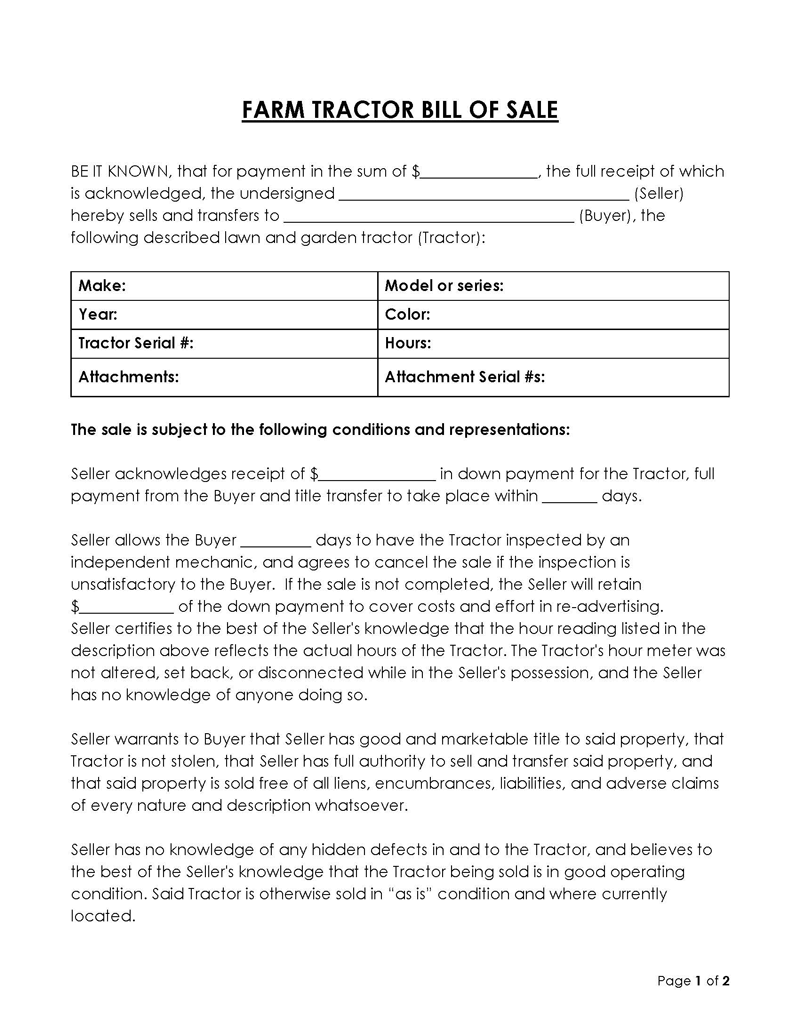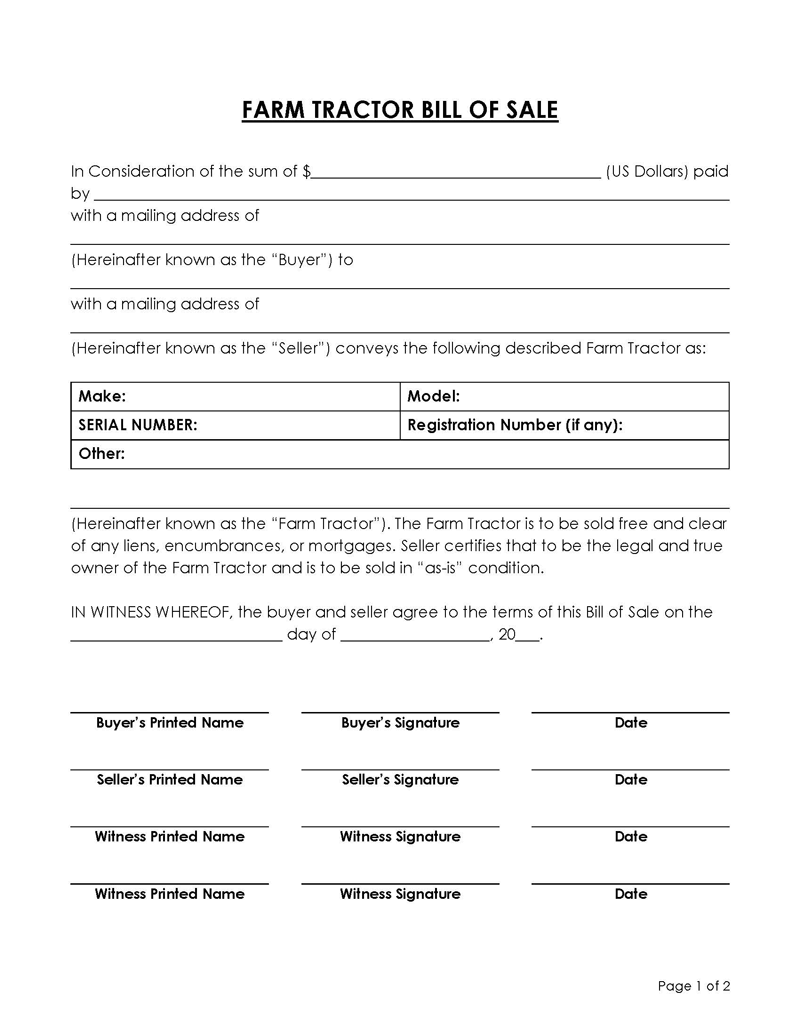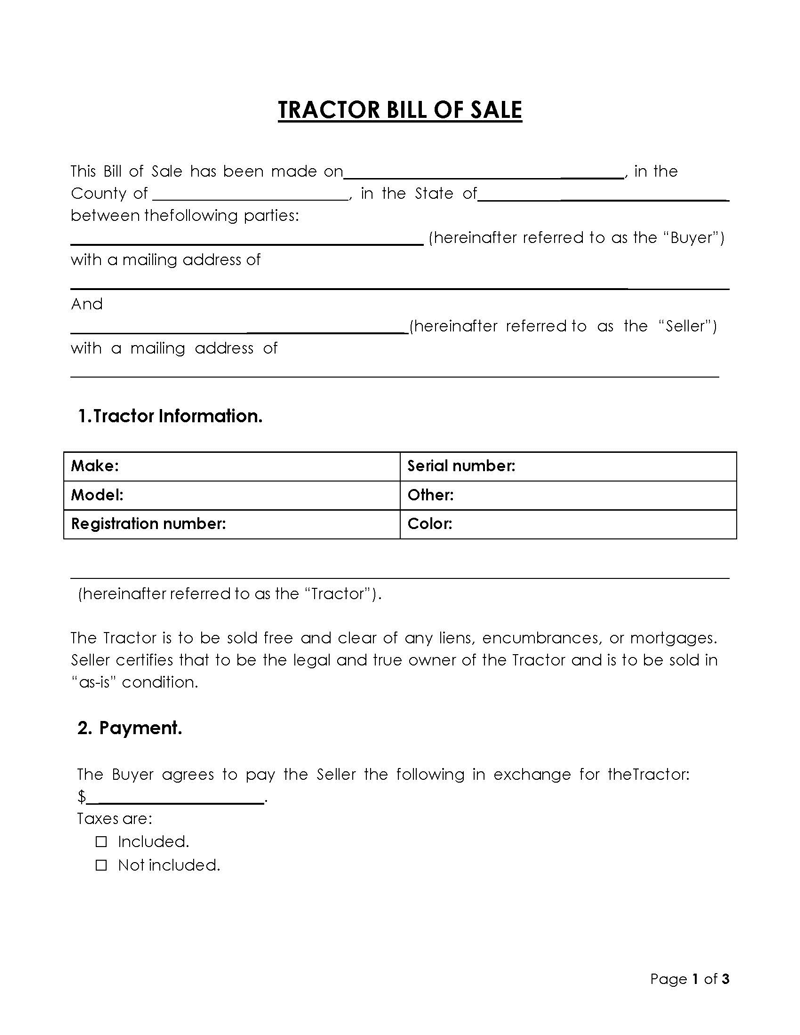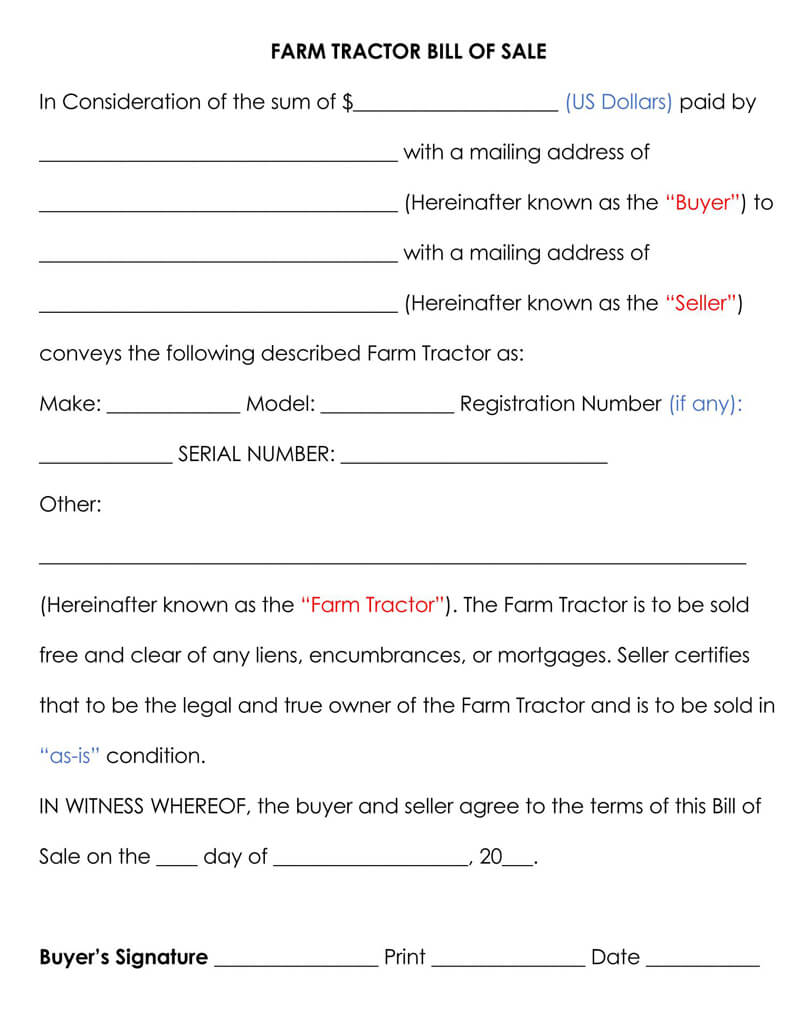When the time comes that you have to sell your tractor, you will need to obtain a document known as the Tractor Bill of Sale Form to legalize the transfer of ownership. A tractor bill of sale form binds the buyer and the seller in the transaction, proving that an agreement was reached and the transaction was successful.
Any prospective buyer must understand that the tractor is released on ‘as is’ terms, which means that the seller will no longer be responsible for the tractor. Therefore, all checks, including mechanical scrutiny, should be completed before committing to the document.
A tractor bill of sale form captures different types of information, including the description of the machine, the amount paid, and the payment method. Once ready, the document is an impactful proof of ownership, acts as legal liability for both parties, and can be used when it comes to accounting.
What is the Purpose of Tractor Bill of Sale Form
The question of whether a tractor really needs a tractor bill of sale document arises all the time. A tractor is an expensive investment, especially when you want to sell it with associated mounting machinery. Therefore, it is in your best interest to ensure that both you and the buyer acquire the tractor bill of sale form during the transaction. In addition, you can use the document to disentangle yourself from legal responsibility if the vehicle was used in illegal dealings after you have sold it. Similarly, some states have set up a rule that it’s mandatory to present the tractor bill of sale form if the new buyer wishes to reregister or insure the equipment.
Downloadable Tractor Bill of Sale Forms
Step by Step Guide on How to Sell a Tractor
Selling your tractor is no easy task, but there are things you can do to ensure that you sell it to the right party and for a fair price.
Here is a step-by-step guide to streamline the whole process from the time you decide to sell to the day of the actual transaction:
Make thorough repairs and clean the tractor
For a tractor that has been actively performing heavy tasks around your farm, it is almost inevitable that it has sustained some damages here and there. These damages could be in the engine, systems, body, and more. In this line, conduct any necessary repairs to restore the tractor to a desirable working condition. After completion of the repair works, test every component, including accessories, for any working disorders. Lastly, clean the tractor thoroughly inside and out.
When cleaning the tractor, pay close attention to cracks and other openings on the outer side of the tractor, removing all embedded dirt and debris. Check and polish rusted metal parts and clean the upholstery as it speaks volumes about the overall condition of the tractor. Suppose there are any tears or splits in the fabrics; repair or consider replacing them. A thorough cleaning helps because buyers like to go for attractive and good-looking machinery when comparing their options.
Put together all the paperwork
Regardless of their offer, any kind of buyer will want to see proper documentation that proves beyond any doubt that you are the legal owner of the tractor. Also, prudent buyers want to ensure they will have proper documentation should they want to use the machinery to secure a loan in the future.
Some of the documents to have in place include the original user’s manual, tractor title if it has one, proper maintenance activity records, previous transfer of ownership if applicable, and registration documents. You should also have the unique serial number associated with the tractor and accessories.
Assemble accessories and affiliated materials
Have in mind that selling tractor accessories like a rotary tiller separately does not necessarily mean that you will make more money. In fact, many buyers look to buy the whole package to save themselves from the headache of having to source attachments separately. This is especially prevalent among buyers of older tractor models whose compatible accessories can be hard to come by.
Create a competitive advertisement
After preparing everything, it is time to fish out the ideal buyer using a well-crafted advertisement.
An ideal tractor advertisement should bear the following information:
- A predetermined, well-researched price tag
- Clear photos that capture different views of the machinery and associated components
- A mention of the chain of ownership and assurance of availability of corresponding documents
- The tractor’s specs, starting with the most desirable ones
- A mention of any existing damages
An excellent advert is precise, honest, and attractively tells the tractor’s story to catch the eye of any potential buyer over competitive listings.
Select places to advertise
With the possibilities that the internet presents, there are multiple platforms where you can stage your advertisement. While it’s hopeful of putting up ads on almost every platform, it makes more sense to concentrate on-farm sales websites such as Tractor House. Other ideal avenues to list your tractor include the newspapers, local swap sheets, and categorized sites like Craigslist’s and eBay. However, it helps to mention that you can only allow a physical pick-up in order to keep scammers off. Therefore, the tractor itself should be parked at a local dealership, preferably one that predominantly deals with farm machinery.
Remember that farm tractor sales are not as common as other types of vehicles. With this in mind, you have to be ready to wait about five months from the time of your initial listing before landing the ideal buyer.
Become an excellent negotiator
If you made an excellent advert, potential buyers would start to contact you, and it is up to you to select the one you want to engage further. It is natural for a buyer to try to make you drop the price considerably, but that is the whole point of informed negotiations. Be keen to enter the negotiations phase with the optimal selling points of the tractor at your fingertips. Once you have agreed on a price, it is time to make it official.
Information to Include in the Tractor Bill of Sale Form
Fill in the following information to come up with a complete tractor bill of sale form:
- Date of sale- indicate the year, month, and date of the transaction
- Seller information- including your full name, license number, address, email, and phone number and contact information
- Buyer information- similarly, fill in the buyer’s name, license number, residential address, and contact information
- The tractor’s information- this section of tractor bill of sale should capture as many details about the tractor as possible. List the make, model, year of manufacture, identification number, mileage or hours it’s been operational, condition, and a precise description of the machinery.
- The sale price- indicate the price as agreed upon and the preferred payment method.
- Signatures- make the tractor bill of sale official by including the signatures of the buyer, seller, and the witnesses involved
- Public notary involvement- the transaction’s final step involves sourcing a certificate of acknowledgment from your public notary to prove that the sale is complete and recognized publicly.
Related: All-Terrain Vehicle (ATV) Bill of Sale Form
Essential Tips to Consider When Selling your Tractor
The following tips will help to streamline the entire tractor sale process:
Make a pressing repair
Some factors influence the decision of a potential buyer more than others. For example, a rusting roof cannot compare to a faulty engine. In this line, prioritize your repairs by fixing all areas that drastically influence the effectiveness of the tractor. In addition, it’s in your best interest to hire a mechanic to ensure all components of the engine, including spark plugs, battery, and gearbox, are in desirable condition.
Get rid of any decorative additives
Buyers like to see the tractor in pristine condition. As such, remove any parts or art you may have added in the name of decorations. This may include your farm’s name or even a ‘cool-looking custom tractor spoiler. The less dramatic the tractor looks, the more likely a prospective buyer will like it.
Conduct an extensive cleaning
Buyers understand that they are purchasing a used tractor, but that should not be a reason to go slow on the looks. Cleaning extensively is very important as it removes stubborn dirt, stains and unclogs various parts. You may also go-ahead to hire a professional to repaint certain parts to foster the aesthetic value of the machinery.
Take impressive pictures
Your pictures go a long way in influencing whether a prospective buyer will contact you or go to the next ad. As such, you should take photos using an incredible camera. Similarly, don’t hold back from adding a clear photo of any disoriented part, as it could make the buyer trust you more. The pictures should feature many angles and close-ups of vital parts such as the engine, joinery, and wheels. Additionally, you can add photos that show the serial number, make, and model of the tractor.
Invest in online advertisements
Online advertising is a great way to automate your marketing. Publishing your advert on various online platforms extends your reach and increases your chance of selling the tractor in a short period of time. Depending on your budget, you can choose between free listings, paid listings, or both. Tractor House, Equipment Trader, and Craigslist are excellent platforms to start with.
Be pragmatic on the pricing
An extremely overpriced or underpriced price tag can birth doubtful feelings in a prospective buyer’s mind and prompt them to move on. For this reason, you should take your time to research a reasonable price for the tractor.
Estimating the value of your tractor
There are many factors that determine the price of your tractor. These include climatic season, model, age, mileage, and associated accessories. You can browse online listings for similar ads to have a rough idea of the standard market price before factoring in the tractor’s condition.
Discovering the serial number and year of your tractor
The unique serial number of your tractor can uncover different types of information, including the year it left the factory. You can read the unique identifier on various parts of the tractor, especially the engine. To decipher what the serial number carries, check it up on Google. (Type brand of the tractor and serial number).
A tractor bill of sale form is basically a receipt to mark the transaction as successful. It protects both the seller and the buyer from issues that may arise after the closure of the deal. Always remember to check out the law surrounding signage of the tractor bill of sale form, depending on your state.
Free Template
Following is a free downloadable tractor bill of sale template for you:
Frequently Asked Quesstions
What is a VIN number on a tractor?
Like other vehicles, every tractor comes with a unique vehicle identification number. Tractors produced before 2014 had a 6-digit number, but that has since changed to 17 digits. The location of the number may depend on the brand, but it’s conventionally embedded on the right side of the steering capsule.
How do I look up a serial number?
To find what information the serial number carries, you can check it out using a search engine. For example, type the brand, make, and the serial number and hit search. You can also search the serial number on dedicated online resources, such as Vin decoder.
How do you prove ownership of a tractor?
While a certificate of title is good proof of ownership, many farm tractors are not titled. In this line, you may prove ownership of a tractor through a manufacturer certificate of origin, a tractor bill of sale form, or the receipt issued to you at the time of buying.
Do you get a title with a tractor?
Getting a title for your tractor largely depends on your state. A state like Texas does not offer titles for farm tractors, while Louisiana lets new owners decide if they want to obtain titles.
